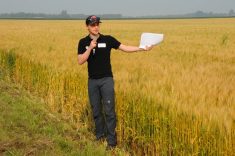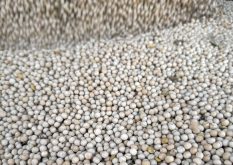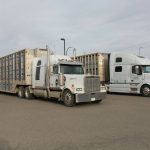VEGREVILLE, Alta. – A plastic dish pan with a mop handle screwed to its side is all farmers need to estimate how much grain is lost during harvest, says a combine specialist.
Les Hill, manager of business development and technical services with the Prairie Agricultural Machinery Institute in Humboldt, Sask., said it is virtually impossible to know how much canola is thrown from the combine by searching for black seeds on black soil.
Farmers are fooling themselves if they think they can adjust their combines properly without using basic measuring tools such as a dishpan or a drop pan bolted on the bottom of a combine, Hill told farmers at a Combine Clinic in Vegreville July 27.
Read Also

Agri-business and farms front and centre for Alberta’s Open Farm Days
Open Farm Days continues to enjoy success in its 14th year running, as Alberta farms and agri-businesses were showcased to increase awareness on how food gets to the dinner plate.
He said he’s seen hundreds of farmers running beside the combine with a scoop shovel hoping a few seeds will land in the shovel so that they can estimate yield loss. The farmers make a few adjustments and then run behind the combine again with the shovel, only this time holding the shovel in for twice as long to get a better sample.
Usually there will be twice as many kernels in the shovel and the farmers’ will curse because they think twice as much has been tossed out the combine.
Hill said the trick to getting an accurate sample is holding the one-foot square pan under the combine for the same time before and after the adjustments are made.
You have to get it where the combine is dropping the straw onto the
“access=subscriber section=crops, news, none
ground to get any kind of measurement,” he said.
The Canola Council of Canada and PAMI have developed a seed loss guide for calculating loss, but on most combines, a three inch by three inch area in the corner of a pan, weighing three grams and taking up the space of three loonies, means one bushel per acre of canola is being tossed out the combine.
In wheat, it’s about 20 kernels in the one square foot tub, or the size of a toonie.
Hill said farmers can be even more accurate by building a drop pan and attaching it to the bottom of their combine.
He said it’s up to farmers to judge how much time they want to spend ensuring the maximum amount of grain is going into the hopper in perfect condition. Even the most efficient motor doesn’t run at 100 percent efficiency.
Hill said farmers may not stop their combines to pick up a quarter tacked to a stake every few metres in the field, but they might stop their combine if a $5 bill was tacked to each stake.
It’s the same with combine adjustments. He said it’s almost impossible to stop every kernel from being tossed out the back, but it is possible to keep most of the kernels in the combine.
Jim Owen of Irma, Alta., said he has used the scoop shovel testing method to check for lost grain, but liked the idea of mounting a drop box under his combine.
“Those drop boxes are a good idea. I think I’ll make one.”














